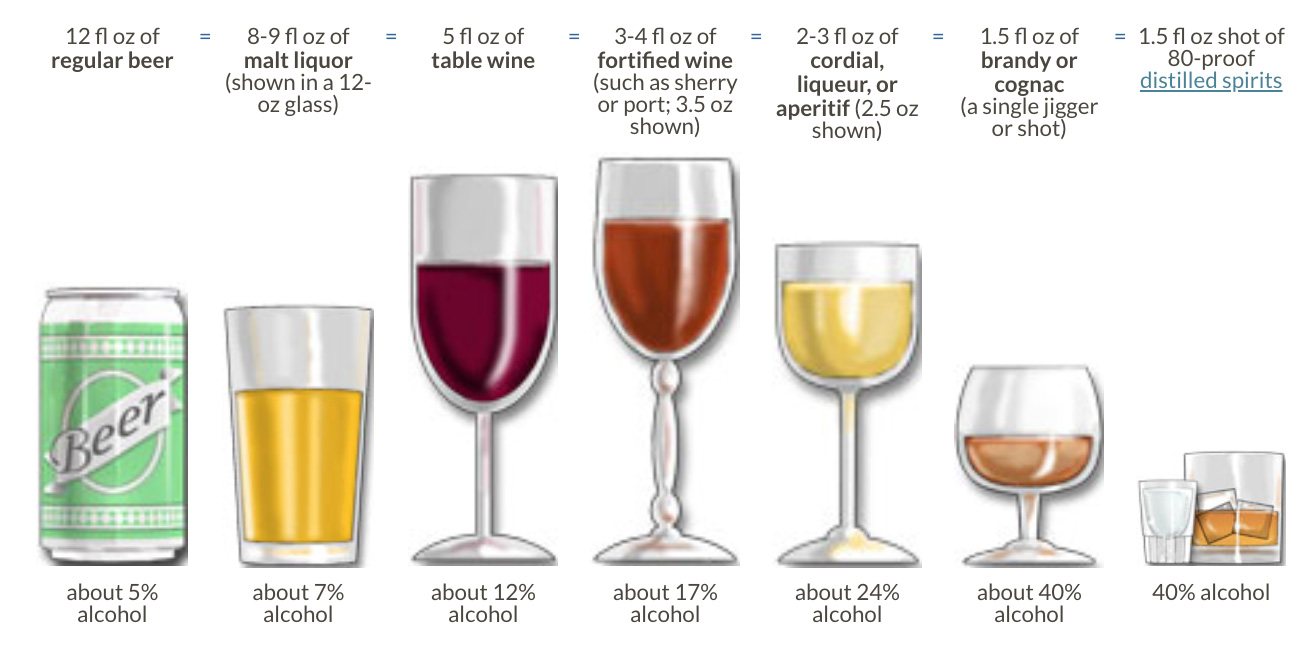Your community resource for addiction education, prevention, and recovery.
For an emergency, call 911
Alcohol 101
- Home
- Addiction & Substances
- Substances 101
- Alcohol 101
What you need to know:
Alcohol is one of the most commonly used drugs in the U.S., and the effects of alcohol vary depending on a person’s age, sex, weight, how often and how much they drink, health status, and family history.
The strength of alcohol in a drink, whether it’s beer, wine or a cocktail, depends on the type of alcohol that is being consumed. Many people are surprised that what counts as one drink in their glass or bottle may not match the amount of alcohol they think they are consuming. The “standard drink” in the US is categorized as:

**Percentage of alcohol may vary depending on the product brand (photo from https://www.rethinkingdrinking.niaaa.nih.gov/)
What are the risks?
There are many risks associated with alcohol consumption. Even at low levels, alcohol can impact decision making, memory, coordination, and concentration. Alcohol can have negative, sometimes irreversible, impacts on some of our essential organs, including the liver, heart, and brain and may cause long-term damage to a person’s body. Drinking alcohol increases a person’s risk for developing many types of cancer.
No matter how much you drink, driving is not safe. The national Blood Alcohol Concentration (BAC) limit is 0.08.
People who drink to excess and are physically dependent on alcohol may be diagnosed with Alcohol Use Disorder (AUD). Symptoms of withdrawal, including headaches, nausea, anxiety, hallucinations, and seizures, will begin just 8 hours after a person’s last drink. These symptoms are extremely serious and can result in death. For a person whose body has become physically addicted to alcohol, it is important to seek medical help when decreasing or stopping alcohol use.
Know the data:
According to the 2018 MetroWest Adolescent Health Survey, 48% of Natick High School students drank alcohol in their lifetime, and 27% drank in the past 30 days.
Between 2010 and 2012, Massachusetts had 11.9 million total deaths by alcohol poisoning. The state ranked the highest amongst those on the east coast.
According to the Centers for Disease Control and Prevention (CDC), more than 90% of the alcohol consumed by those under age 21 is consumed by binge drinkers (defined as 5 or more drinks per occasion for boys; 4 or more drinks per occasion for girls).
|
Resources, Tips and Support During COVID-19.
|
Privacy Overview
| Cookie | Duration | Description |
|---|---|---|
| cookielawinfo-checkbox-analytics | 11 months | This cookie is set by GDPR Cookie Consent plugin. The cookie is used to store the user consent for the cookies in the category "Analytics". |
| cookielawinfo-checkbox-functional | 11 months | The cookie is set by GDPR cookie consent to record the user consent for the cookies in the category "Functional". |
| cookielawinfo-checkbox-necessary | 11 months | This cookie is set by GDPR Cookie Consent plugin. The cookies is used to store the user consent for the cookies in the category "Necessary". |
| cookielawinfo-checkbox-others | 11 months | This cookie is set by GDPR Cookie Consent plugin. The cookie is used to store the user consent for the cookies in the category "Other. |
| cookielawinfo-checkbox-performance | 11 months | This cookie is set by GDPR Cookie Consent plugin. The cookie is used to store the user consent for the cookies in the category "Performance". |
| viewed_cookie_policy | 11 months | The cookie is set by the GDPR Cookie Consent plugin and is used to store whether or not user has consented to the use of cookies. It does not store any personal data. |